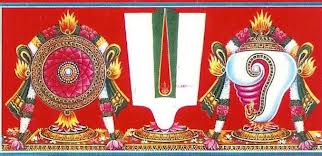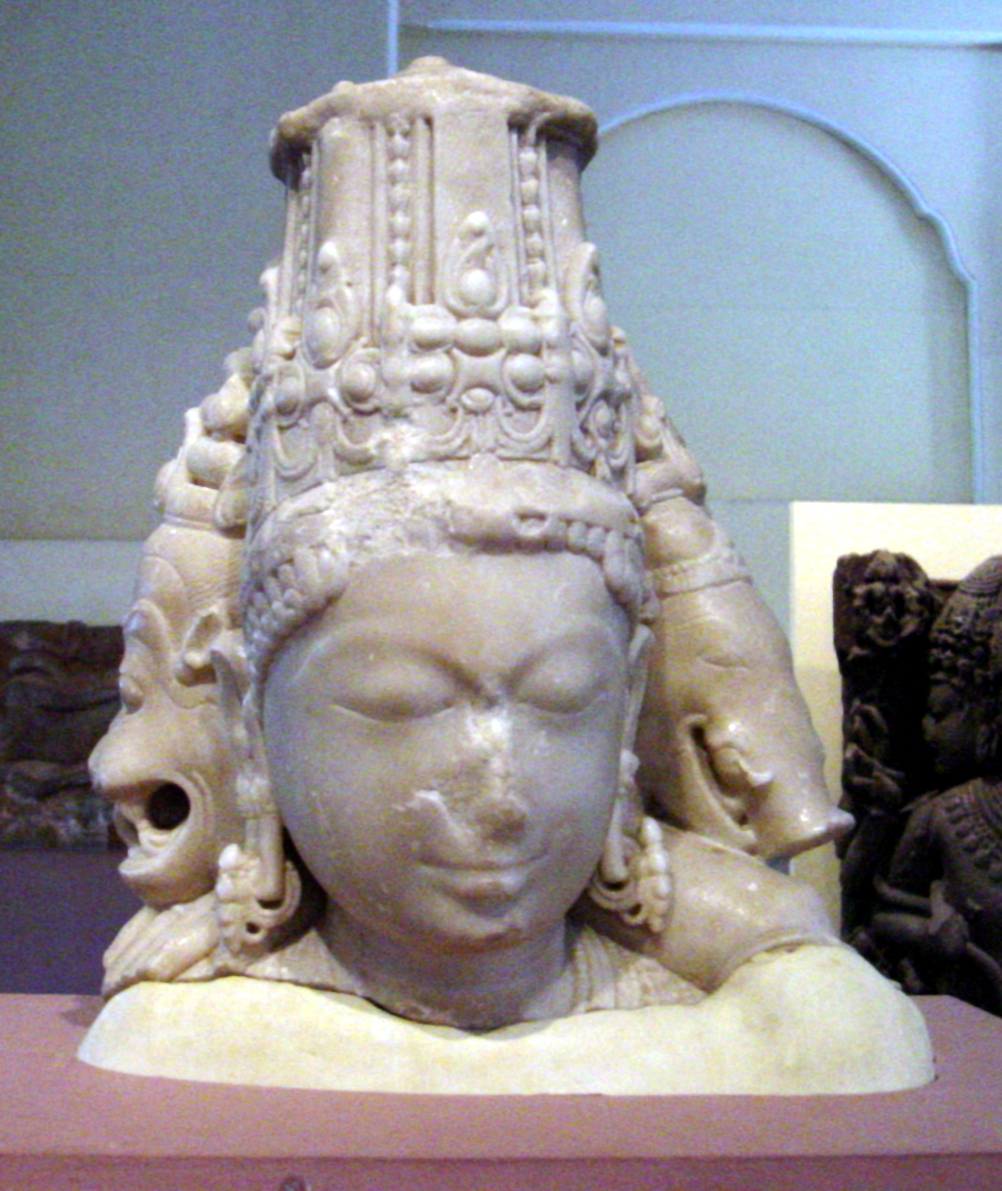|
Samasrayana
{{Hindu philosophy Samasrayana or Pancha Samskara (meaning Five Purifications) is a Pañcaratra rite practiced in all forms of Vaishnavism. Samasrayana means 'to approach with all sincerity and truthfulness to Acharya'. During this rite, the acharya initiates a person, irrespective of sex, caste, social status etc., as his or her sishya. It is a commitment from the disciple that he or she will live as per the wishes of the acharya. Thus, the person gets the link to the Vaishnava tradition. Samasrayana consists of the guru bringing the initiate into the srivaishnava ''flock'' through five steps: (1) thapaha-embossing the impression of Vishnu's sudarshana discus on the right shoulder of the initiate and of Vishnu's panchajanya conch on the left shoulder of the initiate - using an ember-heated silver seal; (2)pundraha-introducing the twelve locations in the body where Vishnu resides and thus are to be marked with the Vaishnava tilak sign; (3)dasaha tatha namaha-adding the suffix das ... [...More Info...] [...Related Items...] OR: [Wikipedia] [Google] [Baidu] |
Srivaishnava
Sri Vaishnavism, or the Sri Vaishnava Sampradaya, is a denomination within the Vaishnavism tradition of Hinduism. The name refers to goddess Lakshmi (also known as Sri), as well as a prefix that means "sacred, revered", and the god Vishnu, who are together revered in this tradition. The tradition traces its roots to the ancient Vedas and Pancharatra texts, popularised by the Alvars and their canon, the Naalayira Divya Prabandham. The founding of Sri Vaishnavism is traditionally attributed to Nathamuni of the 10th century CE; its central philosopher has been Ramanuja of the 11th century, who developed the ''Vishishtadvaita'' ("qualified non-dualism") Vedanta sub-school of Hindu philosophy. The tradition split into two denominations around the 16th century. The Vadakalai sect vested the Vedas with the greatest authority and follow the doctrine of Sri Vedanta Desika, whereas the Tenkalai sect vested the Naalayira Divya Prabandham with the greatest authority and follow the princ ... [...More Info...] [...Related Items...] OR: [Wikipedia] [Google] [Baidu] |
Ramanuja
Ramanuja (Middle Tamil: Rāmāṉujam; Classical Sanskrit: Rāmanuja; 1017 CE – 1137 CE; ; ), also known as Ramanujacharya, was an Indian Hindu philosopher, guru and a social reformer. He is noted to be one of the most important exponents of the Sri Vaishnavism tradition within Hinduism. His philosophical foundations for devotionalism were influential to the Bhakti movement. Ramanuja's guru was Yādava Prakāśa, a scholar who according to tradition belonged to the Advaita Vedānta tradition, but probably was a Bhedabheda scholar. Sri Vaishnava tradition holds that Ramanuja disagreed with his guru and the non-dualistic Advaita Vedānta, and instead followed in the footsteps of Tamil Alvārs tradition, the scholars Nāthamuni and Yamunāchārya. Ramanuja is famous as the chief proponent of Vishishtadvaita subschool of Vedānta, and his disciples were likely authors of texts such as the Shatyayaniya Upanishad. Ramanuja himself wrote influential texts, such as bhāsya on t ... [...More Info...] [...Related Items...] OR: [Wikipedia] [Google] [Baidu] |
Srivaishnavism
Sri Vaishnavism, or the Sri Vaishnava Sampradaya, is a denomination within the Vaishnavism tradition of Hinduism. The name refers to goddess Lakshmi (also known as Sri), as well as a prefix that means "sacred, revered", and the god Vishnu, who are together revered in this tradition. The tradition traces its roots to the ancient Vedas and Pancharatra texts, popularised by the Alvars and their canon, the Naalayira Divya Prabandham. The founding of Sri Vaishnavism is traditionally attributed to Nathamuni of the 10th century CE; its central philosopher has been Ramanuja of the 11th century, who developed the ''Vishishtadvaita'' ("qualified non-dualism") Vedanta sub-school of Hindu philosophy. The tradition split into two denominations around the 16th century. The Vadakalai sect vested the Vedas with the greatest authority and follow the doctrine of Sri Vedanta Desika, whereas the Tenkalai sect vested the Naalayira Divya Prabandham with the greatest authority and follow the principl ... [...More Info...] [...Related Items...] OR: [Wikipedia] [Google] [Baidu] |
Pañcaratra
''Pancharatra'' ( IAST: ''Pāñcarātra'') was a religious movement in Hinduism that originated in late 3rd-century BCE around the ideas of Narayana and the various avatars of Vishnu as their central deities.Pancharatra: religious movement Encyclopaedia Britannica The movement later merged with the ancient Bhagavata tradition and contributed to the development of . The Pancharatra movement created numerous literary treatises in Sanskrit called the ''Pancharatra Samhitas'', and these have been influential |
Vaishnavism
Vaishnavism ( sa, वैष्णवसम्प्रदायः, Vaiṣṇavasampradāyaḥ) is one of the major Hindu denominations along with Shaivism, Shaktism, and Smartism. It is also called Vishnuism since it considers Vishnu as the sole Para Brahman, supreme being leading all other Hindu deities, i.e. ''Mahavishnu''. Its followers are called Vaishnavites or ''Vaishnava''s (), and it includes sub-sects like Krishnaism and Ramaism, which consider Krishna and Rama as the supreme beings respectively. According to a 2010 estimate by Johnson and Grim, Vaishnavism is the largest Hindu sect, constituting about 641 million or 67.6% of Hindus. The ancient emergence of Vaishnavism is unclear, and broadly hypothesized as a History of Hinduism, fusion of various regional non-Vedic religions with Vishnu. A merger of several popular non-Vedic theistic traditions, particularly the Bhagavata cults of Vāsudeva, Vāsudeva-krishna and ''Gopala-Krishna, Gopala-Krishna'', and Narayana, ... [...More Info...] [...Related Items...] OR: [Wikipedia] [Google] [Baidu] |
Acharya
In Indian religions and society, an ''acharya'' (Sanskrit: आचार्य, IAST: ; Pali: ''ācariya'') is a preceptor and expert instructor in matters such as religion, or any other subject. An acharya is a highly learned person with a title affixed to the names of learned subject. The designation has different meanings in Hinduism, Buddhism and secular contexts. ''Acharya'' is sometimes used to address an expert teacher or a scholar in any discipline, e.g.: Bhaskaracharya, the expert mathematician. Etymology The Sanskrit phrase ''Acharam Grahayati Acharam Dadati Iti Va'' means ''Acharya'' (or teacher) is the one who teaches good conduct to one's students. A female teacher is called an ''achāryā,'' and a male teacher's wife is called an ''achāryāni'' In Hinduism In Hinduism, an ''acharya'' is a formal title of a teacher or guru, who has attained a degree in Veda and Vedanga. Prominent acharyas in the Hindu tradition are as given below : *Adi Sankaracharya *Raman ... [...More Info...] [...Related Items...] OR: [Wikipedia] [Google] [Baidu] |
Sudarshana
Sudarshana Chakra (Sanskrit: सुदर्शन चक्र, lit. "disc of auspicious vision", IAST: Sudarśana Chakra) is a spinning, celestial discus with 108 serrated edges, attributed to Vishnu and Krishna in the Hindu scriptures. The Sudarshana Chakra is generally portrayed on the right rear hand of the four hands of Vishnu, who also holds the Panchajanya (conch), the Kaumodaki (mace), and the Padma (lotus). While in the Rigveda, the Chakra was Vishnu's symbol as the wheel of time and by the late period, the Sudarshana Chakra emerged as an ayudhapurusha (an anthropomorphic form), as a fierce form of Vishnu, used for the destruction of demons. As an ''ayudhapurusha'', the deity is known as Chakraperumal or Chakratalvar. Etymology The word ''Sudarshana'' is derived from two Sanskrit words – ''Su''(सु) meaning "good/auspicious" and ''Darshana'' (दर्शन) meaning "vision". In the Monier-Williams dictionary the word Chakra is derived from the root क्र� ... [...More Info...] [...Related Items...] OR: [Wikipedia] [Google] [Baidu] |
Panchajanya
Panchajanya ( IAST: Pāñcajanya) is the ''shankha'' or conch of the Hindu preserver deity Vishnu, known to be one of his four divine attributes. It is stated to have been one among the various substances that emerged during the Samudra Manthana. According to the Mahabharata, Purushottama (Vishnu) killed a daitya (a member of a clan of asuras) named Panchajana on a mountain named Chakravan constructed by Vishvakarma, and seized the conch shell in which Panchajana had lived for himself. The conch is named after the daitya. In Literature In the Bhagavad Gita, the Panchajanya is mentioned: As per the Harivamsa, Krishna, the avatar of Vishnu, is described as possessing a conch shell called Panchajanya, one of his four attributes together with the mace Kaumodaki, the disc-like weapon Sudarshana Chakra, and a lotus. The conch was used during the Kurukshetra War, and is held in popular tradition to have signalled its beginning. Origin There are two origins stated in the script ... [...More Info...] [...Related Items...] OR: [Wikipedia] [Google] [Baidu] |
Tilak
In Dharmic culture, the ''tilaka'' ( sa, तिलक) () is a mark worn usually on the forehead, at the point of the Ajna chakra, or sometimes another part of the body such as the neck, hand, chest or arm. ''Tilaka'' may be worn daily or for rites of passage or special spiritual and religious occasions only, depending on regional customs. The term also refers to the Hindu ritual of marking someone's forehead with a fragrant paste, such as of sandalwood or vermilion, as a welcome and an expression of honour when they arrive.Axel Michaels (2015), ''Homo Ritualis: Hindu Ritual and Its Significance for Ritual Theory'', Oxford University Press, , pp. 100-112, 327 Historically, ''tilaka'' were also used in other Dharmic cultures including Buddhism, Jainism and Sikhism, which were influenced by Hinduism and its spiritual and philosophical beliefs. Description The tilaka is a mark created by the application of powder or paste on the forehead. Tilakas are vertical markings worn by ... [...More Info...] [...Related Items...] OR: [Wikipedia] [Google] [Baidu] |
Dasan
Jeong Yak-yong (August 5, 1762 – April 7, 1836) or Chong Yagyong, often simply known as ‘Dasan’ (茶山, one of his ‘ho’ / pen-names meaning ‘the mountain of tea’), was a Korean agronomist, philosopher, and poet. He was one of the greatest thinkers in the later Joseon period, wrote highly influential books about philosophy, science and theories of government, held significant administrative positions, and was noted as a poet. He was a close confidant of King Jeongjo (ruled 1776-1800) and his philosophical position is often identified with the Silhak (practical learning) school, and his concerns are better seen as explorations of Neo-Confucian themes. Jeong was born in Gwangju, Gyeonggi Province and died in there too. He spent 18 years in exile in Gangjin County, South Jeolla Province, from 1801 until 1818, on account of his membership of the Southerners (''Nam-in'') faction, and also because of the Catholic faith of his elder brother. Korean Catholics sometimes cl ... [...More Info...] [...Related Items...] OR: [Wikipedia] [Google] [Baidu] |
Mantram
A mantra (Pali: ''manta'') or mantram (मन्त्रम्) is a sacred utterance, a numinous sound, a syllable, word or phonemes, or group of words in Sanskrit, Pali and other languages believed by practitioners to have religious, magical or spiritual powers. Feuerstein, Georg (2003), ''The Deeper Dimension of Yoga''. Shambala Publications, Boston, MA Some mantras have a syntactic structure and literal meaning, while others do not. The earliest mantras were composed in Vedic Sanskrit in India. At its simplest, the word ॐ (Aum, Om) serves as a mantra, it is believed to be the first sound which was originated on earth. Aum sound when produced creates a reverberation in the body which helps the body and mind to be calm. In more sophisticated forms, mantras are melodic phrases with spiritual interpretations such as a human longing for truth, reality, light, immortality, peace, love, knowledge, and action. Some mantras without literal meaning are musically uplifting and ... [...More Info...] [...Related Items...] OR: [Wikipedia] [Google] [Baidu] |





